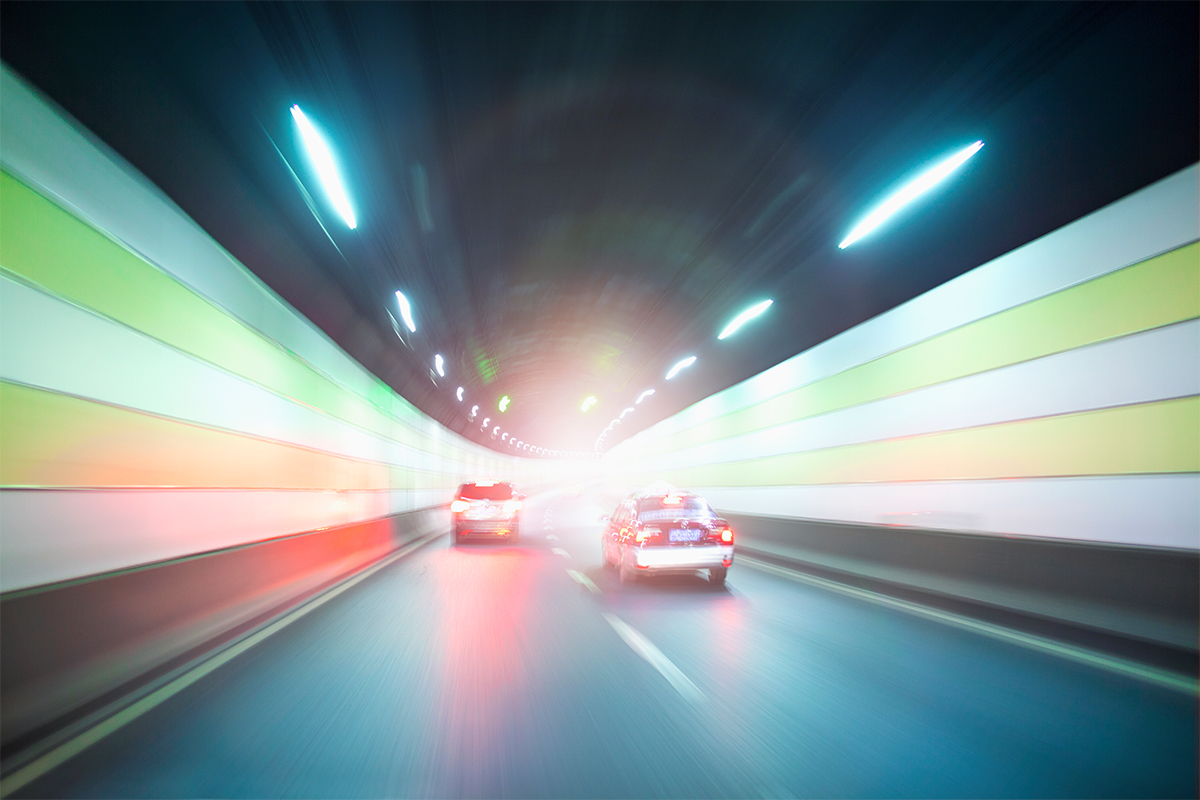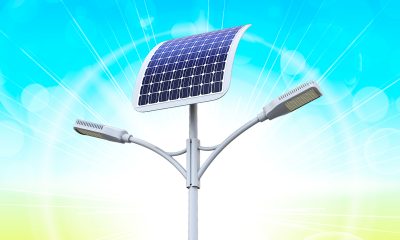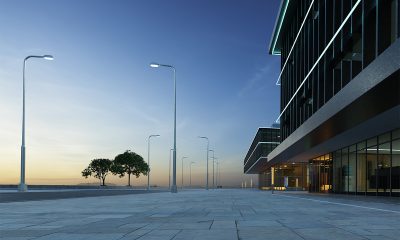Tunnel and underpass illumination
A tunnel is an enclosed passage which restricts the normal daytime illumination of the roadway and produces a shadow that limits the ability of the driver to see objects or obstructions within the structure. Tunnel lighting is provided to illuminate the presence and movement of other road users or objects. It helps define the tunnel’s geometry such that a motorist is encouraged to maintain speed and able to safely navigate through the tunnel. The more heavily the world is populated, the more tunnels are needed to free up valuable ground areas or to cross mountain ranges and bodies of water, and the more important tunnel lighting becomes.
Due to the complex and highly specialized needs of the application, tunnel lighting is challenged to facilitate the flow of vehicular and/or pedestrian traffic efficiently and effectively. It must address a diversity of concerns, including traffic density and speed, luminance contrast, eye adaptation, flicker effects, glare, and the luminaire performance and reliability under heavy duty use and harsh environmental conditions. The category of tunnel lighting products also includes those used for illuminating underpasses. An underpass is defined as a covered or underground passage of which the length and physical configuration do not substantially reduce a driver’s ability to see objects ahead.
Tunnel lighting zones
Tunnel lighting design breaks down the internal tunnel areas into several zones which include the threshold zone, transition zone, interior zone, and exit zone. The threshold zone is the area between the portal (the plane of entrance into the tunnel) and the beginning of the transition zone. Good tunnel lighting should create smooth transitions from light to dark in order to overcome the black hole effect and avoid safety implications due to the transitional loss of visual acuity.
The threshold zone requires very high luminance values so that the eye can adapt and see inside the tunnel. The threshold luminance values are primarily determined by the ambient luminance of the surface adjacent to the tunnel portal during the daytime. Once the eye is no longer exposed to exterior luminance and has adapted to the visual environment within the tunnel, a transition can be made to a lower, more economical level of tunnel interior lighting.
The transition zone is the area which allows drivers to achieve eye adaptation by incrementally reducing the level of luminance until it reaches to the level of luminance in the tunnel interior zone. The interior zone is the portion of the tunnel where the vision has adapted to the designed luminance environment.
Legacy tunnel lighting technologies
A tunnel light is designed to accommodate the lumen output, light distribution, lighting control and mounting requirements of a specific application and engineered to survive the harsh environment found in all tunnels. The selection of light sources defines how the tunnel lighting luminaire is designed and engineered.
In the past, tunnel lighting had been provided by a variety of light sources, including fluorescent lamps, metal halide (MH) lamps, high pressure sodium (HPS) lamps, and low pressure sodium (LPS) lamps. These light sources have some common disadvantages such as high optical loss due to their omni-directional light output, the use of large optical systems for light extraction and control, poor physical durability, limited switching cycles, and expensive lighting maintenance. Additionally, fluorescent lamps have reduced efficiency at both high and low ambient temperatures, HPS and MH lamps require a long restrike time in the event of momentary power interruption and have poor uniformity of light distribution, LPS lamps have a poor color rendering index (CRI) and short lamp life. These limitations and inefficiencies ultimately translate to a high total cost of ownership (TCO) that directly affects the bottom line.
LED lighting takes performance and efficiency to new heights
The advent of LED technology ushers in a new era of tunnel lighting. LEDs are semiconductor devices that emit light through recombination of the positive and negative charge carriers (injection electroluminescence). LEDs are very efficient in energy conversion from electrical power to optical power and offer many advantageous features such as long lifespan, excellent dimming capability, high physical durability, small size, directionality, precise control of the spectral power distribution (SPD), instant start/restrike, high frequency switching capability, and cold temperature operation. These characteristics lend LED tunnel lighting systems a high lighting application efficiency (LAE), which accounts for optical delivery efficiency, intensity effectiveness, and spectral effectiveness of the delivered SPD.
The flexibility of LES (light emitting surface) design with discrete LEDs enables more freedom in new lighting form factors and optical control. LED tunnel lights are capable of producing consistent light distributions for uniform luminance of tunnel interior surfaces. The uniformity ratio tolerances relative to the values within each zone are 2.0 to 1, average-to-minimum, and 3.5 to 1, maximum-to-minimum. LED tunnel lights can be designed in a linear form for continuous lighting, eliminating concern for flicker effects due to spatially periodic changes in luminance. Another advantages of employing LED technology for tunnel lighting applications is the ability to provide adaptive threshold zone lighting according to the external lighting conditions. LEDs are inherently dimmable. They can be operated by an intelligent LED driver which is able to be programmed or work with environmental sensors to control the amount of light from the LEDs on demand.
Light source
LED tunnel lights can take various forms, but the essentials of good design and engineering remain the same. The disadvantages of LED’s interdependent performance upon the thermal and electrical system applied call for a holistic approach to system development. The LED package selection not only defines the luminaire’s color characteristics—the correlated color temperature (CCT) and color rendering properties, but also determines the upper limits of the luminaire efficacy and system life. The package design has a direct influence in the luminous efficacy and lumen maintenance.
Among all types of LED packages mid-power LEDs have the highest efficacy due to the use of reflective housings made from a resin such as PPA, PCT, and EMC. However, most tunnel lighting applications place high thermal and electrical stresses on the light source. Under demanding operating conditions, the plastic housing of a mid-power package can rapidly discolor and lose reflectivity which, in combination with the silver-plated leadframe, contributes the light source’s high initial efficacy. In contrast, high power LED packages eliminate the use of plastic housings and corrosion-prone leadframes and are designed with high capacity thermal and electrical conduction paths to resist the stresses from high current and flux density operations. Although the luminous efficacy of these packages is traded for thermal stability, the excellent lumen maintenance enables a substantially higher ROI than the plastic LED packages.
Thermal management
Thermal management is especially a priority in tunnel lighting applications due to the long running hours and relatively high wattages typically involved. LEDs dissipate power locally on the package in the form of heat which must be transferred away from the LED junction. Failure to remove the heat will elevate the operating temperature of the LED. High operating temperatures can accelerate crystal defect formations in the epitaxial layer structure of the indium gallium nitride (InGaN) LEDs and the degradation of packaging materials, resulting the permanent reduction of the internal quantum efficiency and light extract efficiency.
The amount of heat that can be removed from the LED junction depends upon the ambient temperature and the design of the thermal path from the LED chip to the surroundings. Therefore, in addition to the use of high operating temperature capable LED packages, the thermal path must have adequate capacity to handle the applied power load. Thermal resistance of all components along the entire thermal path must be minimized by maximizing material thermal conductivity and removing interfacial thermal resistance. Meanwhile, the effective surface area of the thermal path must be maximized to facilitate conductive and convective thermal transfer.
The heat sink is the most important part of the thermal path. It is usually constructed from die cast or extrude aluminum and may implement aerodynamic design for maximization of air flow. Yet adequate heat sinking is not all of thermal management. The temperature increases in an LED can be caused by increased drive currents, which dictates the need for tight drive current regulation.
LED driver
At the very heart of an LED tunnel light is the LED driver that converts alternating current (AC) line power to a voltage and current compatible with the LED array. LED drivers are usually designed as switching mode power supply (SMPS) systems that employ various circuit topologies, such as half-bridge, flyback for the galvanically isolated type and buck, boost for the non-isolated type, to regulate DC output power with good power factor correction and low harmonic content (THD). It is essential that the circuit efficiency of the LED driver is optimized while providing minimal current ripples required by the LED load. For increased versatility in light output, the LED driver may also interpret control signals from a DALI, 0-10V, or wireless controller to dim the LEDs.
Transient voltage suppression must be one of the key aspects to think about as power surges and other electrical events that cause abnormalities in power quality can damage LEDs and sensitive circuits and components in LED drivers. LED drivers incorporate various safety features such as short circuit and overload protection, soft start, and intelligent overtemperature protection. When installing the LED driver in a fixture, it is highly important to thermally isolate the driver from the light engine so that the LED thermal load will not add to the thermal stress on the temperature sensitive components, particularly electrolytic capacitors.
Light distribution
Effective optical design exploiting the directional nature of LED light emission can translate to a high optical deliver efficiency, excellent glare control, and uniform distribution of light across the target area. Control of light distribution from LED tunnel lights is commonly achieved with lenses, reflectors, or a combination of them. Ceiling mounted LED tunnel lights are available with symmetrical and asymmetrical distributions. Symmetrical tunnel lights produce a distribution pattern that is similar in all directions and creates a uniform luminance throughout the tunnel interior. Asymmetrical tunnel lights include those producing negative contrast light distributions (ALD-NC) and positive contrast light distributions (ALD-PC).
ALD-NC is also known as counterbeam. The counterbeam system distributes luminaire flux predominantly toward the oncoming driver in a controlled manner, which provides high pavement luminance and low object luminance (negative contrast) while reducing glare. ALD-PC is also known as probeam. The probeam system forwards the beam of light in the direction of the traffic flow, which results in high object luminance and low pavement luminance (positive contrast).
System reliability and durability
Tunnel lights must be ruggedly constructed to withstand the challenging tunnel environment. Vehicles traveling at a high rate of speed cause repeated vibration which demands a robust mechanical design. Of particular importance is the reliability of solder joints or interconnects between the LED packages and circuit board. The optical assembly and driver compartment should be thoroughly sealed and gasketed to prevent ingress of vapor, dust, and water jet spray. The corrosiveness associated with vehicle emissions from round-the-clock traffic and high levels of humidity requires that the aluminum housing and mounting hardware have high corrosion protection performance.



















Loading...